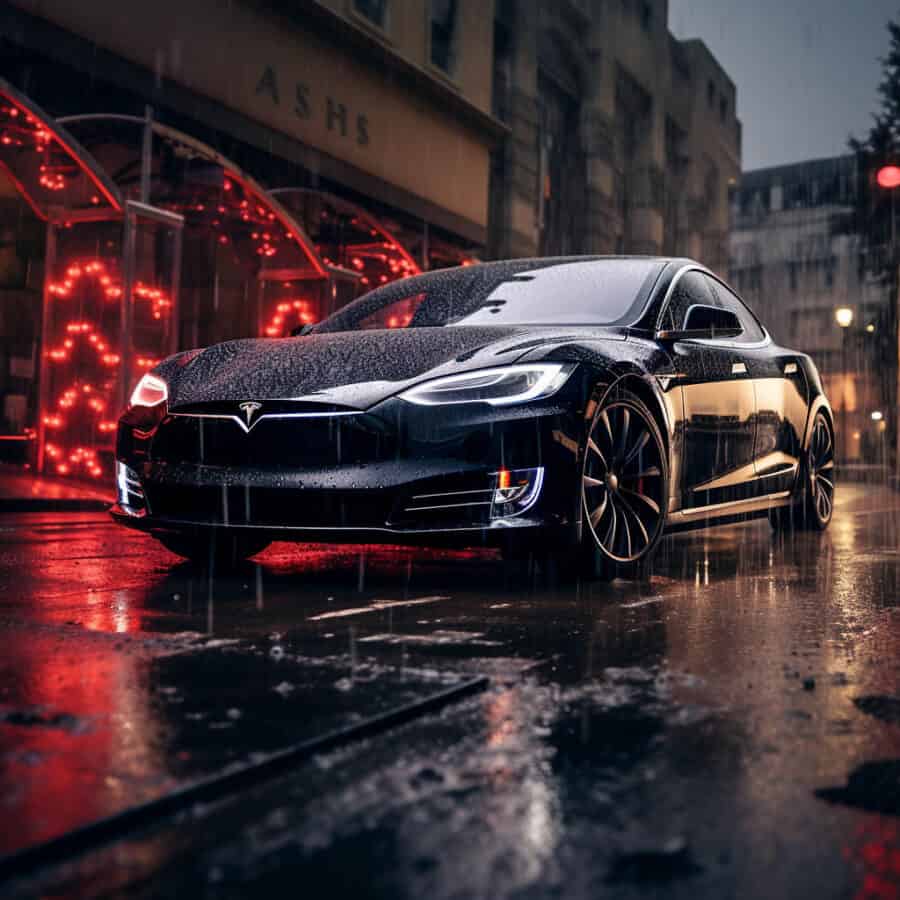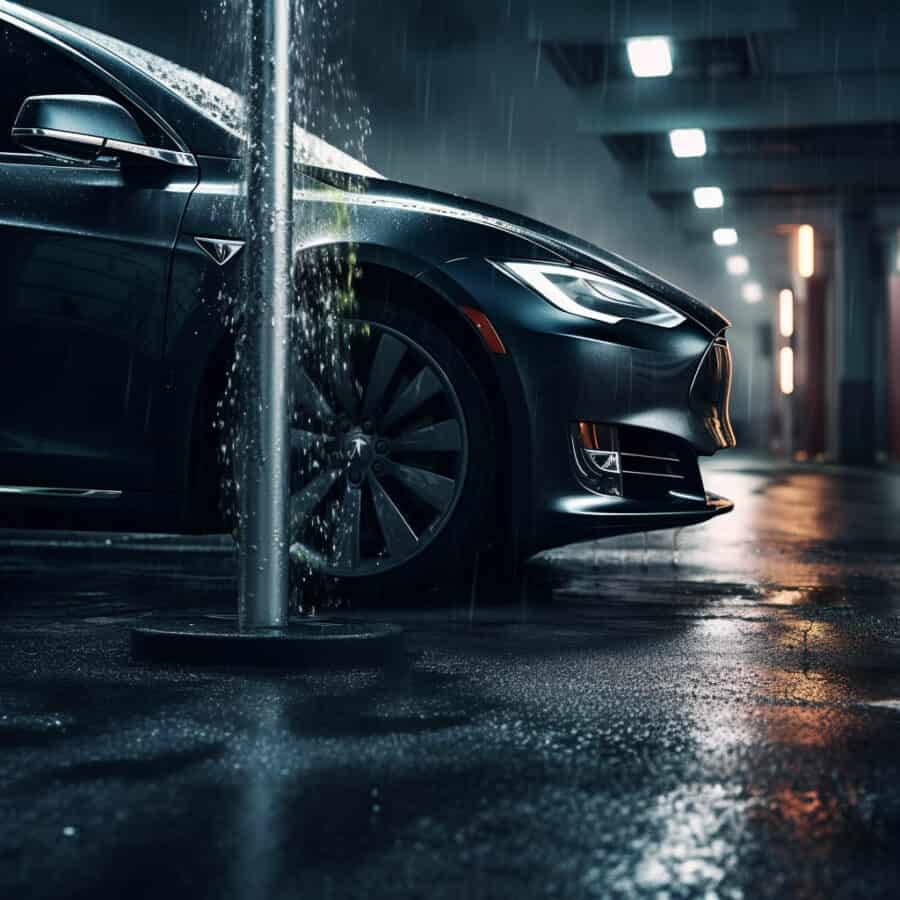Can a Tesla charger get wet? This is a question that many electric vehicle owners may have, especially during inclement weather conditions. Charging ports and electricity don’t mix well with water, which naturally leads to concerns about the safety of charging your Tesla in the rain or snow.
In this blog post, we will explore the intricacies of Tesla’s charging systems and their capability to withstand various environmental conditions, including rain or snow. We’ll explore whether the tesla charging port is waterproof, how to safely charge your vehicle at home or at supercharger stations, and precautions you need to take while using mobile chargers.
We will also provide insights on maintaining charger integrity during harsh weather situations like heavy rain or freezing temperatures. So can a Tesla charger get wet? Stay tuned as we unravel this query comprehensively.
Tesla Charging in Wet Conditions
Charging your Tesla vehicle during wet conditions might seem risky, but thanks to the robust safety measures implemented by Tesla, it’s entirely possible. However, there are some precautions you should take for an optimal charging experience.
Importance of keeping charging cables dry
The first rule is to ensure that all charging cables and connectors are completely dry before use. This reduces any risk of electrical issues or damage to your charger or vehicle. Don’t be a fool, keep your cables dry.
Home Charging Your Tesla Safely
Charging your Tesla at home can be convenient and cost-effective. When bad weather hits, like hail or lightning storms, it’s essential to be vigilant and take safety measures while charging your Tesla at home.
Safe Practices for Home Charging
- Avoid charging in standing water or during severe storms.
- If you’re using an extension cord, make sure it’s rated for outdoor use and the correct amperage.
- In case of a power outage, unplug your vehicle to prevent potential damage from power surges when electricity is restored.
Benefits of Installing a Level 2 Charger
Level 2 chargers, which run on 240 volts, can charge your Tesla significantly faster than standard wall outlets. They also come with additional safety features like ground fault protection and are typically hardwired into your electrical system by a professional electrician. This ensures they are installed safely and correctly according to local codes and regulations.
For more information on home charging safety, check out this Tesla support page.
Maintaining Charger Integrity During Harsh Weather Conditions
Harsh weather conditions can pose challenges to your Tesla’s charging system. However, with proper precautions and maintenance, you can ensure its longevity and performance.
Positioning Mobile Charger Installations Correctly
Your Mobile Connector installation should be above ground level to prevent water or snow from reaching it. This helps in avoiding potential electrical hazards and maintaining the integrity of the charger.
Dealing with Frozen Chargers
In freezing rain scenarios, avoid using forceful attempts to unplug a frozen charger as this could cause damage. Instead, use safe methods such as gently rocking the connector back and forth until it loosens up. Remember that pouring hot water over them is not recommended due to the risk of thermal shock causing premature wear and tear on your Tesla’s charging equipment.
Don’t let harsh weather conditions put a damper on your Tesla’s charging capabilities. By adhering to these instructions, you can guarantee your charger’s optimal performance and availability when needed.
Understanding Technical Specifications for Safety in Wet Environments
Tesla’s commitment to safety extends beyond the vehicle itself, right down to its charging equipment. The chargers are designed with a focus on waterproof and dustproof designs, ensuring safe operation even in wet conditions.
Waterproof & Dustproof Designs of Chargers
The Tesla Wall Connector and Mobile Connectors have been engineered to withstand environmental factors like rain and windblown dust. They feature robust casings that protect against water ingress, thus maintaining their integrity during adverse weather situations. You can find more about these features from the official Tesla support page.
Precautions to Take While Charging in Diverse Environmental Situations
Charging your Tesla during diverse environmental situations, like thunderstorms, can be a concern for many owners. However, the risk is minimal due to the watertight battery packs engineered for rainy condition operations.

Advised Precautions During Thunderstorms
- Avoid charging if there’s a severe storm warning in your area.
- If you’re already charging when a storm starts, it’s generally safe to let it continue unless instructed otherwise by local authorities or Tesla support.
- In case of lightning strikes nearby, disconnecting the charger could be a wise precautionary measure.
The only exception to this rule is freezing rain scenarios. The chargers aren’t designed to handle such conditions and may malfunction or get damaged as a result. Waiting for improved conditions is advisable prior to attempting any form of charging when freezing rain is present.
FAQs in Relation to Can Tesla Charger Get Wet
Is it safe to leave a Tesla charger outside?
Yes, the Tesla Mobile Connector is designed to withstand outdoor conditions, but it’s best to avoid exposing it to extreme weather for prolonged periods.
Can I wash my Tesla while it’s charging?
No, it’s not recommended to wash your car while it’s charging as water and electricity can be a dangerous combination.
Can you drive a Tesla in the rain?
Absolutely. Teslas are safe and fully capable of driving in rainy conditions thanks to their advanced traction control systems.
Are there any downsides to Tesla vehicles?
While Tesla vehicles are known for their impressive performance and eco-friendliness, some critics have pointed out issues with build quality and customer service.
How does Tesla compare to other electric vehicle brands?
Tesla is often considered the leader in the electric vehicle market, but there are other brands like Nissan, Chevrolet, and BMW that offer their own unique features and benefits.
Conclusion
Is it safe to charge your Tesla in the rain? Yes, but precautions must be taken to ensure safety and protect your charging equipment from damage. Avoid charging in standing water, keep cables dry, and position mobile chargers correctly in harsh weather conditions.
If you’re charging during thunderstorms or other extreme weather conditions, be sure to take the necessary precautions.
By following these guidelines, you can safely charge your Tesla even in wet conditions.

